Easy Mushroom Farro Risotto
This mushroom farro risotto, or farrotto, is hearty, bursting with mushroom flavor and fresh herbs, and uses my favorite no-stir cooking method.
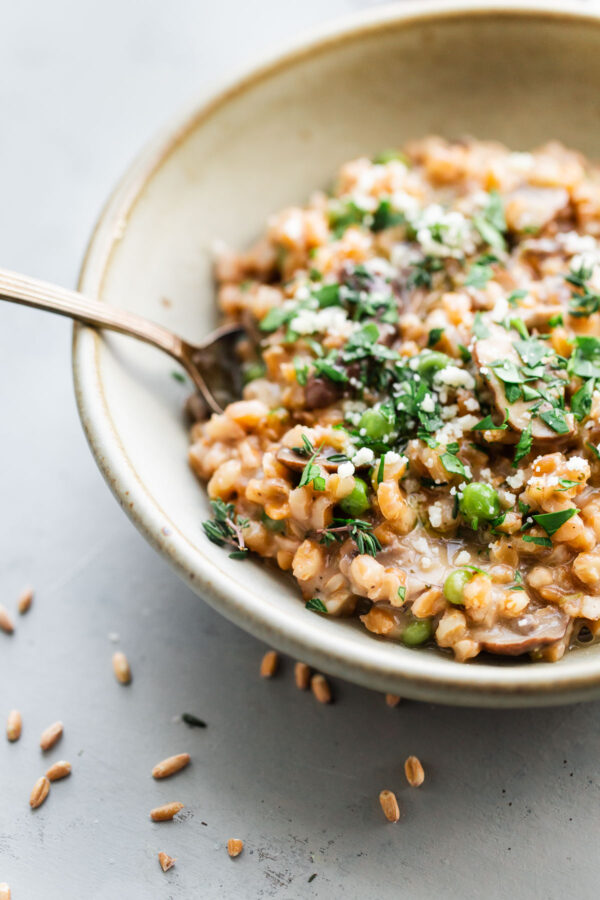
Since spring is at least three months away (welcome to the midwest), I’m excited to bring you all another cozy, healthier dinner to hold us over on these dark cold days. If you live in a warm climate, bless you. And, also, can I come visit?
Nothing says cozy comfort food like a big pot of mushroom farro risotto. As an Italian, risotto is near and dear to my heart. While it’s fun to indulge in a classic risotto every now and then, I might love farro risotto even more!
Farro risotto is hearty, more nutritious, much more forgiving, and offers a wonderful chewy texture that I can’t seem to get enough of.
This mushroom farro risotto is creamy, bursting with mushroom and fresh herb flavor, and uses my favorite no-stir cooking method. I love mushrooms any day of the year, but I particularly appreciate them during this season. Their meaty and rich flavor tides me over. Just before serving, we’ll stir in frozen thawed peas for some color!
I’ve teamed up with my long-time friends at Bob’s Red Mill, who produce my favorite organic farro, for today’s recipe. In case you’re unfamiliar with this grain, I’m covering all the basics below, including what it is, what makes Bob’s Red Mill farro special, and how to prepare it.
If you haven’t tried your hand at farro risotto (or classic risotto!), I hope you’ll give this recipe a try! It’s a winner! For more guidance, be sure to check out the recipe video as well.
What Is Farro?
Many people think that farro is its own strain of grain, but that is not exactly true. Farro is the Italian term for “ancient hulled wheat grain”. It is considered an ancient grain, which is loosely defined as a type of grain that has remained the same for thousands of years.
Farro was a staple food in ancient Rome, partially due its incredible nutritional profile, and is often featured in classic Italian cooking. It comes from one of three wheat varieties: spelt, emmer, or einkorn. Since farro is a wheat product, it is important to note that farro is not gluten free.
A 1/2 cup of cooked farro (1/4 cup dry) provides 7 grams of dietary fiber and 7 grams of protein, as well as potassium and iron.
Once cooked, farro has a great chewy texture (in many ways, it resembles wheat berries and looks similar in ways to barley) and slightly nutty flavor. It is deliciously hearty and filling, and can be used or substituted in a wide variety of dishes: salads, soups and stews, side dishes, and casseroles. I even use it for farro porridge!
What Makes Bob’s Red Mill Farro Different?
The most commonly available farro, including Bob’s Red Mill Organic Farro, is spelt-based. This version also goes by the name ‘farro grande’ or triticum spelta.
Unlike some farros on the market, Bob’s Red Mill lightly scores the farro grains (as evident by the delicate cuts shown below on each grain). Since it is scored and a very small portion of bran is removed, it is technically not considered whole grain.
With that said, the light scoring preserves the majority of the grain’s nutritional content. It also has the added benefit of reducing cook time and promoting starch release. Starch release helps produce a thicker, creamier texture, which makes Bob’s Red Mill farro an excellent substitute for rice or choice for homemade risotto.
For that reason, it is my favorite choice and I highly recommend seeking it out if you make this recipe!
How to Make Farro Risotto
As most of you probably know, traditional Italian risotto is made with arborio or carnaroli rice. Both of these Italian white rices are known for their high starch content, which helps lend risotto its classic, creamy texture.
Classic risotto is made by sautéing aromatics, toasting the grains, deglazing with white wine, and slowly adding hot broth, stirring continuously until each quantity is absorbed, in small batches.
This process allows the starches to release and ensures that the rice doesn’t cook past al dente. While it’s a fairly easy technique, it is a very hands-on process sand requires a lot of attention.
Farro risotto, often called farrotto, is risotto made with farro. Farro takes longer to cook than rice, but produces a heartier, chewier twist on a classic risotto. It is a healthier and more nutritious alternative that tastes just as good.
They are definitely different, but I love farro risotto just as much as traditional risotto! It tends to fill me up and leave me much more satisfied. Leftovers hold up better and with my no-stir method below, it is also simpler to make.
Let that part sink in. Healthier risotto made simple.
What Makes This Farro Risotto Recipe Different:
Since farro doesn’t benefit from the classic risotto cooking method, this recipe uses my favorite no-stir method. This method calls for adding all of the cooking liquid at once, simmering slowly, and stirring just once or twice throughout the entire cooking process.
Wile this mushroom farro risotto takes about an hour of cook time, it only requires about 15 minutes of active cooking time. This leaves you with more times to focus on other things, particular on busy weeknights. Pair it with a salad, and you’ve got a one-pot dinner on table!
Tips for Mushroom Farro Risotto Success:
- To make this recipe more accessible, I chose to exclusively use cremini mushrooms (baby bella mushrooms), which are available at generic grocery stores. For even more nuanced flavor, use any combination of wild mushrooms or added dried porcinis, which provide even more nuanced flavor.
- Please don’t skimp or leave out the cheese! This recipe calls for stirring in a generous 3/4 cup of grated parmigiano-reggiano cheese once the farro has cooked through. It adds amazing flavor and contributes to the overall texture.
- Don’t forget to allow the risotto to sit, covered, for about 5 minutes before serving. I’ve found this extra step helps thicken and release additional starches, and in my experience, results in an improved and more creamy ‘classic risotto-like’ dish.
Other Favorite Farro Recipes
Here are a handful of my other favorite recipes that utilize this grain or can easily be adapted to include it:
- Strawberry Caprese Farro Salad
- Broken Farro Porridge
- Asparagus Salad (use farro in place of wheat berries)
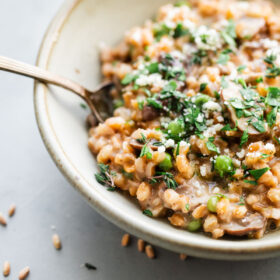
Easy Mushroom Farro Risotto
Ingredients
- 4 cups (1 quart) low sodium chicken broth
- 3 tablespoons unsalted butter
- ½ large yellow onion finely chopped (roughly 1 cup)
- kosher salt
- freshly ground black pepper
- 12 oz cremini (Baby Bella) mushrooms cleaned, trimmed, and thinly sliced
- 3 large garlic cloves finely chopped
- 1 tablespoon finely chopped fresh thyme plus more for garnishing
- 1½ cups Bob’s Red Mill Organic Farro
- ¾ cup dry white wine such as Pinot Grigio
- parmigiano-reggiano cheese rind optional
- ¾ cup grated parmigiano-reggiano cheese plus more for serving
- 1 teaspoon freshly squeezed lemon juice
- ¾ cup frozen peas thawed
- flat leaf parsley finely chopped, for garnishing
Instructions
- Place the chicken broth in medium saucepan and bring to a low simmer. Keep over very low heat.
- In a large Dutch oven (or heavy-bottomed pot), heat the butter over medium heat until melted and lightly bubbling. Add the onion, along with a generous sprinkle of kosher salt, and sauté over medium-low heat for 5 to 7 minutes, stirring often, until the onion is soft and translucent.
- Increase the heat to high. Add the sliced mushrooms and stir to combine. After a minute or so, the mushrooms will begin to sweat and release their moisture. Continue cooking for an additional 2 to 3 minutes, stirring occasionally, until the mushrooms have softened. Add the garlic and fresh thyme and sauté, stirring continuously, for 30 seconds or until fragrant. Season to taste with salt and pepper.
- Add the farro and toast over medium-high heat for 1 to 2 minutes, stirring continuously. The farro will crackle lightly and the pan should be mostly dry.
- Add the white wine and cook over medium-high heat for 2 to 3 minutes, stirring every so often, or until the wine has been completely absorbed. Add the parmigiana rind (if using) and hot broth to the pot, stir to combine, and bring to a boil. Reduce the heat to a steady simmer, cover, and cook for 45 to 50 minutes, stirring every 15 minutes or so, or until the farro is tender (it will naturally be slightly chewy in center) and the risotto is thick. Note: I like to remove the lid in the final 5 to 10 minutes of cooking, which promotes thickening and helps me more easily monitor the texture (i.e. if a fair amount of liquid is remaining, you can increase the heat slightly to reduce, etc.).
- Over low heat, add the grated parmigiano-reggiano cheese and lemon juice and stir to combine. Fold in the thawed peas. Season to taste with kosher salt and freshly ground pepper. If the risotto tastes at all flat, you most likely need to add another generous sprinkle or two of salt.
- Remove the pot from heat, cover, and allow the risotto to sit for 5 minutes before serving. This extra step helps thicken and release additional starches, and in my experience, results in an improved and more creamy ‘classic risotto-like’ texture. Remove and discard the parmigiano-reggiano rind, if using.
- Serve the risotto in pre-warmed bowls. Garnish with fresh thyme leaves, finely chopped parsley, and freshly grated parmigiano-reggiano cheese, as desired.

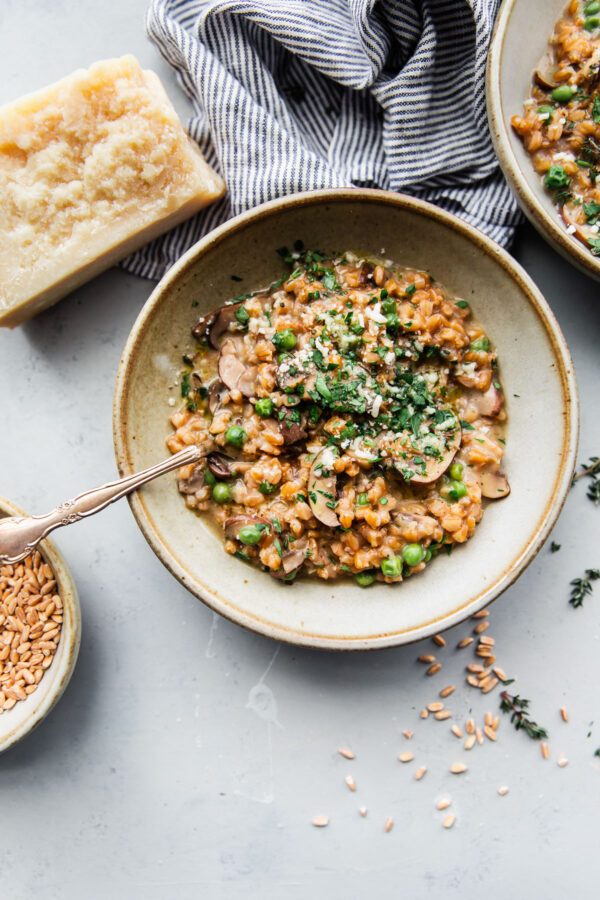
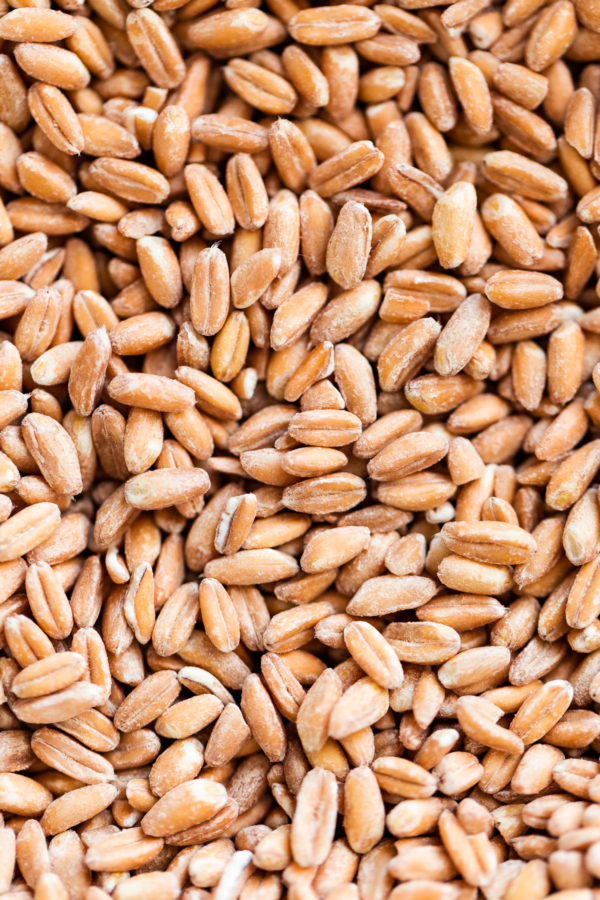
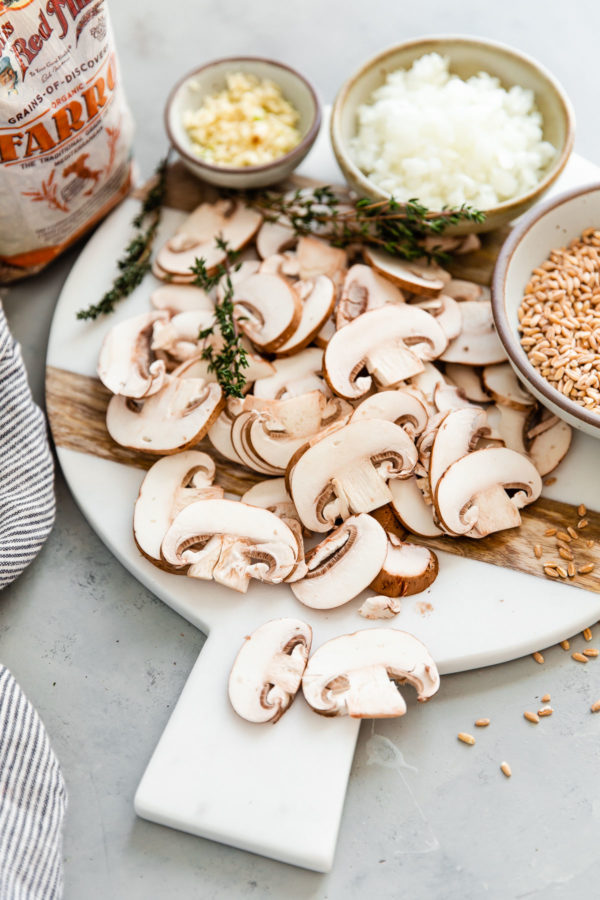
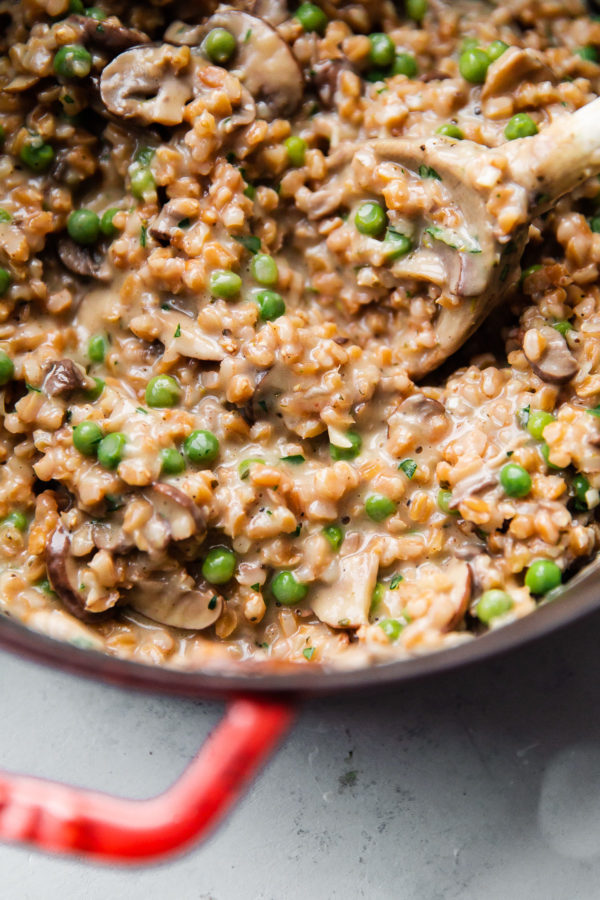
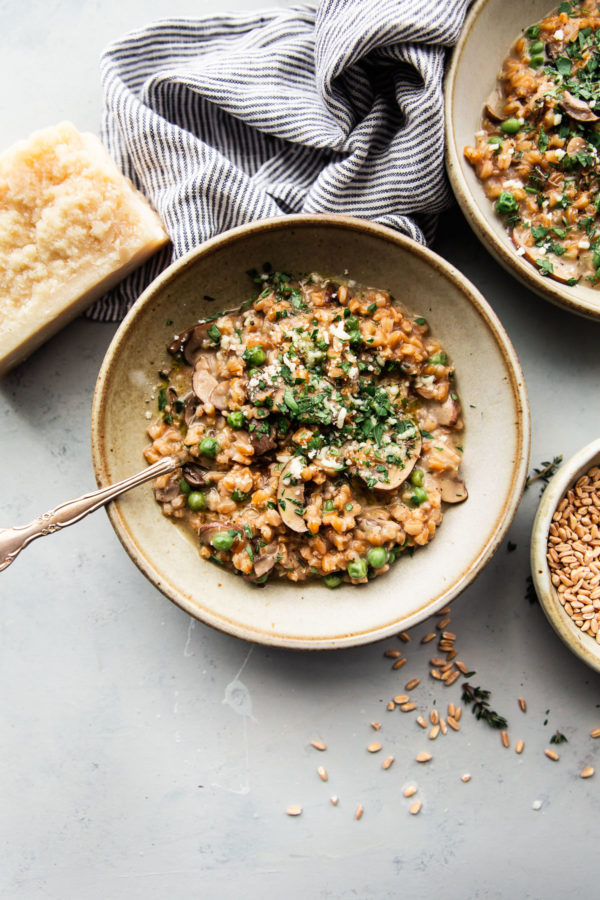
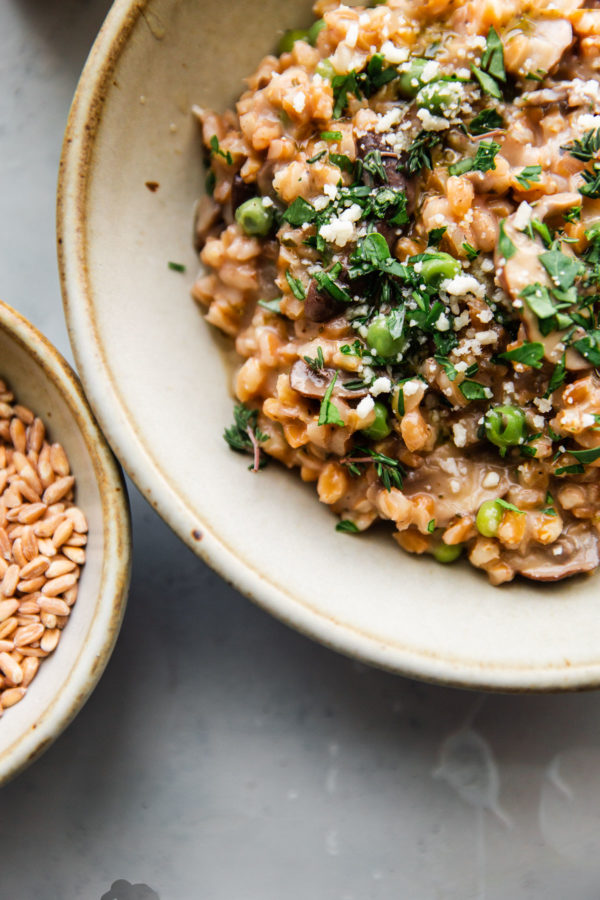
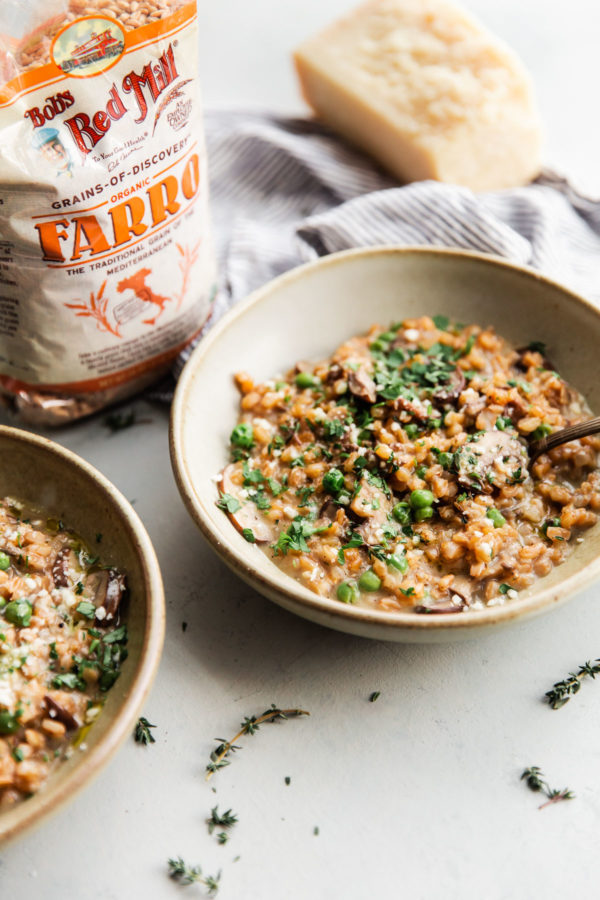
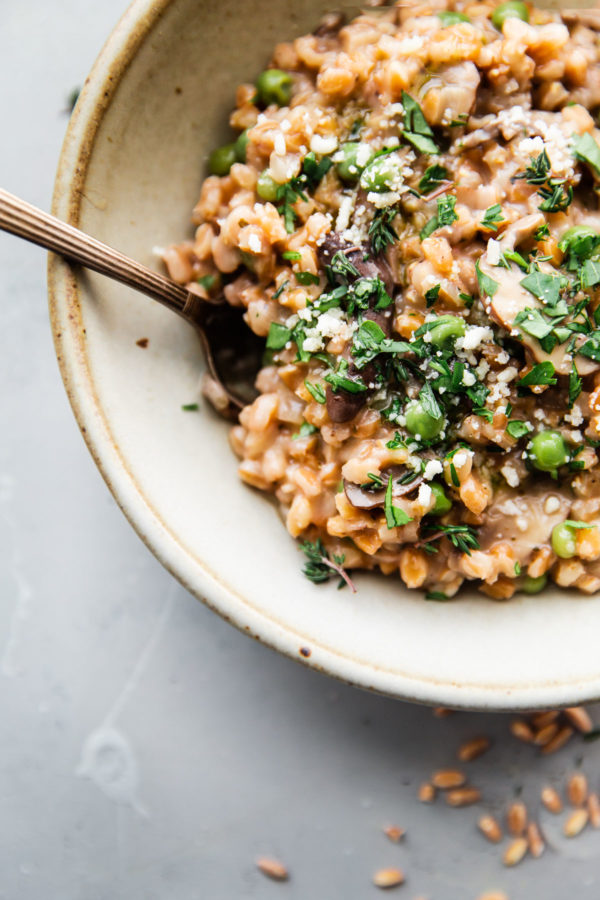
47 Comments on “Easy Mushroom Farro Risotto”
This was delicious! Only change I made was adding a handful of frozen spinach at the end. Great flavor!
This was delicious! Amazing flavor and very hearty. We had it as a side dish to salmon. In this case, a smaller serving size (about half) does just perfectly. The only changes I made were: grated in two dried shiitake mushrooms into my broth and substituted dry vermouth for white wine. This one pot dish is worthy of being in our rotation! Love it!
This was so, so good and easy! I didn’t find the recipe until after I had already poured my farro into some chicken broth, so I only sautéed the mushrooms and onions and then added them to the farro and broth, and it still turned out delicious. Next time I’ll toast the farro first!
How many servings would this be for a side dish?
It’s hard to say, because everyone has a different opinion when it comes to a ‘serving’, particularly side dishes. However, I would say easily 6 people, but 8 is possible as well.
Sometimes I just have to comment because a recipe works great EVEN considering my haphazard cooking style, and this is one of those recipes. Substituted leek for onion, minced dried onion for garlic (the mushrooms would have gone bad if I’d waited until I got garlic…I’m not proud of this), and completely guessed at the chicken stock because I was using frozen chicken jelly plus water. Didn’t have quite enough farro or any frozen peas, and it still turned out just delicious. The texture of the farro is so luscious, and the flavor is wonderfully umami-y!! So, thank you for this excellent recipe, and I look forward to making it (wrong) many more times.
Excellent . Thank you
This recipe was DELICIOUS!! We eat farro several times per week, it’s so much healthier than pasta or rice.. but my husband only likes it with (sometime unhealthy) sauces. He LOVED this recipe, as did I! So much flavor, thanks for sharing, I’m always looking for recipes using farro!!
Great alternative to rice-based risotto. It’s become a staple of my alternating vegetarian dinner nights. I’m making a double batch tonight and I’m gonna try freezing one portion. I’m thinking if I add some broth and put it in the oven to reheat, it should work.
This was SO good! I used asparagus instead of green peas, but that is just personal preference. It turned out so so good! Will make again for sure.
Excellent recipe. I used Chardonnay wine and it came out great. Chicken stock added toward the end to keep it loose. Fresh herbs really helps instead of the dried.
This recipe was absolutely delicious; we all loved it. I made it exactly as written. Thank you for the yummy recipe.
We really enjoyed this recipe! Although, I ended up serving this as a soup instead of a risotto because I used Trader Joe’s 10 minute Farro and was afraid to cook the Farro for the 40 to 50 minutes suggested in step 5. Next time I will try recipe using regular Farro! (Also, for the broth, I just poured it into a big glass bowl and heated it in the microwave instead of using another pot & burner on my stove.)
Hi Jenn! Yep, any sort of 10 minute farro (I’ve seen and bought this product before) is a par-boiled product. Similar to the concept of minute rice.
Regular farro – which is what this recipe uses – has a cook time of more like 30-40 minutes, so you can’t do a direct substitution with a fast cooking grain without changing up the method or liquid considerably. You can definitely use it, but it’s less ideal here.
This was fantastic and so easy to adapt to vegan. I used vegetable broth and nooch instead of parmesan. I also happened to double the mushrooms and used kale instead of peas. Big thumbs up from the fam.
Delicious and easy! I veganized it too by using veg broth, olive oil and vegan parmesan, so so good!
Yummy! Reheats well. Great for a crowd. Total winner.
Thanks so much Nora! So glad you enjoyed it and thank you for taking the time to leave a review!
Delicious. I made this with modifications based on what I had on hand: veggie stock, red wine, red onion and oven roasted portobello mushrooms (served on top, not in the risotto). I served the hot risotto over fresh spinach with roasted portobello mushrooms on top. I was surprised at how well this turned out. We really enjoyed it. And it’s a very flexible recipe!
Does it has to be parmigiano-reggiano cheese? Can I use regular parmesan cheese?
I would personally use true parmigiano or something like grana padano. American Parmesan doesn’t have nearly the same depth of flavor, but you’re of course welcome to make whatever substitutions you want, just know the flavor won’t be quite the same.
I am blown away by this recipe! It has the texture and flavours I have been looking for; I am just sorry I only did half the recipe! But this will be a regular on my menus rotation for sure. I did not feel like opening a bottle of white wine so just replaced by more chicken broth and I skipped the peas. Definitely a dish I would be proud to serve guests!
This makes me so happy to hear! Thank you for taking the time to leave a review!!
Made this recipe tonight and I am so happy with how it turned out! Such a delicious meal and the recipe was so simple. Definitely will be making again! Thank you!
Thanks Lauren!
This looks amazing. I unfortunately have a dairy allergy. Have you tried making this with nutritional yeast?
I have not, I just can’t quit real parmigiano, haha! But I think you could certainly try. It won’t be the same of course, but would definitely help give it some of that cheesiness flavor.
This recipe is sooooooo good! I followed the directions and it was very easy to do. I didn’t have thyme so I subed fresh sage from my garden and a pinch of herbs de provence from my cupboard. The only change I will make next time is I won’t add the peas. I love peas but feel they didn’t quite blend with the other flavors–just my preference. I will definitely make this again. Thank you for this wonderful recipe.
Hi! Can I use Trader Joe’s 10 minute farro (quick-cooking) for this?
Yes! My sister has done this! I’m not sure if the exact adaptations you need to make in terms of cook time, etc. and it might not be quite as creamy, but I know it works and she’s enjoyed it. Hope this helps! ☺️
Is Emmer interchangeable with Farro?
It’s a bit different, but definitely similar because they are both types of wheat berries (in a way). Most farro, especially Bob’s Red Mill, is slightly scored, so it can help with adding a bit of creaminess. You could certainly try making this with emmer, I’m guessing the cook time would be a bit longer and the texture might be a bit different – but absolutely possible.
We are looking for meatless dinner options, this was a HUGE hit at my house! It was easy to make and packed with flavor! It will be added to the dinner rotation. Thank you so much!
So thrilled to hear that!! Thanks so much for taking the time to leave a recipe review, it means a lot!
Just wanted to say this is a great recipe.
I made it when you first published it. This was also my first time cooking with Farro. I’ve had it in deli salads and really like how filling it is.
I was worried about how the risotto would thicken (I’ve watched a lot of Hell’s Kitchen to know it is easier to have a runny risotto than a thick risotto). I did everything you suggested and it came out beautifully and was a hit with my husband. I rarely make recipes more than once but recently I was craving mushrooms and made it again. I had the same success with it this second time around.
Thank you also for sharing your suggestions in the recipe and giving context. Though I’m not new to cooking, it is helpful to have that perspective because I don’t always think about it first time through the recipe. It was also helpful since this was my first time cooking with Farro.
Thanks so much for this recipe! We’re trying to watch our blood sugar so I’ve been wanting to try farro for a while. I’ve had my eye on this recipe for a week and finally made it. Yum! Here’s what I shared on Facebook with the results…
“We tried a new recipe for lunch today… mushroom farro risotto. Aside from going a little too heavy on the cheese, it was a winner! So long as you get your ingredients ready in advance or early on, her minimal stir method really made it easy. Hubby stepped in to help at sautee time so we could keep the recipe moving.
She called for adding green peas at the end, but I used sauteed asparagus and black eyed peas instead. I didn’t have thyme or parsley so I used Italian seasoning, and I only had a shaved parmagian blend so it was a little too easy to add too much.
Oh, and I found the farro at Cost Plus World Market a while back for a reasonable price.
All in all, totally worthwhile!”
So glad you enjoyed it!
I LOVE traditional risotto but this is now my favorite way to make it! The flavors in this dish are incredible and it doesn’t turn into a big, gloppy mess when reheated. Thank you!!
So thrilled to hear that! Thanks so much for the feedback and taking the time to leave a review, I really appreciate it!
Any changes to coming time if I halve the recipe?
No, it shouldn’t affect the recipe much! I would just keep an eye on the sautéing step (and use a smaller pot, obviously) because it might go a touch faster. Great question!
No farro in my cupboard but I do have sorghum….can I substitute? Thanks!
I am so excited to make this recipe and try farro for the first time. Big mushroom fan and always looking for something different. I am a non-drinker and do not care to cook with wine. Do you have an alternative substitution/suggestion? Thank you.
Hi Lizzie! So excited to hear that you’re going to try farro for the first time! Looking forward to hearing what you think. The wine is definitely not essential or necessary in risotto, but it does add acid, which helps balance all of the other flavors. If I would simply leave it out and perhaps add an extra squeeze of fresh lemon juice just before serving – and adjust as necessary to taste! Hope this helps!
Wow! Just finished making this recipe and devouring a large serving. Absolutely love farro and don’t know how I’ve missed this grain my entire life. Very hearty, wonderful flavor and really enjoyed with mushrooms. Not a fan of peas, so instead I added fresh chopped asparagus that I sauteed. Added extra fresh lemon juice to replace the wine. Thank you for introducing farro to me and this delicious recipe Laura.
I discovered farro just a couple of years ago, and it’s replaced rice in our kitchen. I love the nutty flavor and the texture. Bob’s Red Mill has the best products. Love this recipe and it’s what’s for dinner tonight. Thank you.
Isn’t it the best?! I love using it as a substitute for rice too. I feel like it just has a much better texture, especially for salads, side dishes, etc.! Thank you so much, and please come back and let me know what you think once you make it – so excited to hear your thoughts.